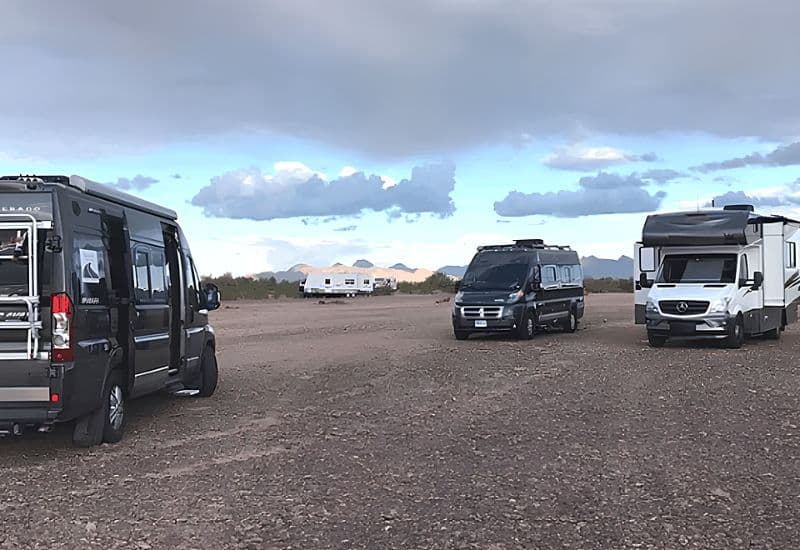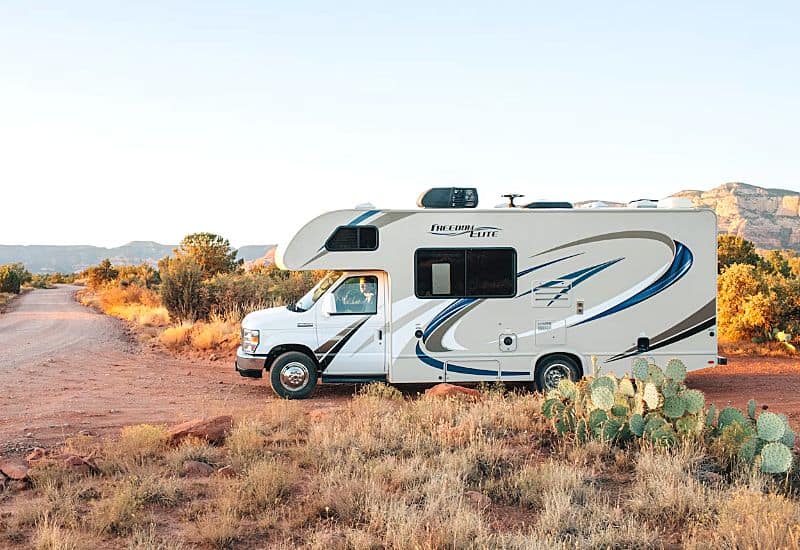Class C motorhomes offer the perfect balance between large Class A RVs and small Class B camper vans.
By providing interior space similar to a Class A while maintaining a smaller footprint closer to a Class B.
Yet, a question that often arises is just how small a Class C RV is and more specifically how wide are they, as this can impact the RV’s comfort and layout as well as its driving and handling.
Not to mention route planning, campsite access, parking, storage, and even fuel efficiency.
Because of this, we thought, we would create this quick resource, which lists the widths of some of the most popular Class C RVs.
So that you have a better understanding of just how wide a Class C RV is.
Plus, we’ll also discuss:
- What is the Standard Width of a Class C Motorhome?
- How Width Affects the Class C Motorhome
- How Does Class C Width Compare to Class A & B Widths?
- Pros & Cons of Different Motorhome Widths
- Legal Restrictions & Road Regulations
Key Takeaways
- Standard exterior widths for Class C motorhomes fall between 7 1/2 and 8 1/2 feet.
- The most common Class C width hovers around 8 feet or 96 inches.
- Class C RV width affects driving dynamics, comfort, layout, route planning, campsite access, vehicle safety, parking, and fuel efficiency
Popular Class C RV Widths (Narrowest to Widest)
| Make/Model | Exterior Width | Overall Size | Price Range |
|---|---|---|---|
| 1. Winnebago EKKO | 7′ 3″ | Compact | Mid-Range |
| 2. Coachmen Cross Trail EV | 7′ 6″ | Compact | Entry-Level |
| 3. Thor Motor Coach Gemini | 7′ 6″ | Compact | Entry-Level |
| 4. Winnebago View | 7′ 7″ | Compact | Mid-Range |
| 5. Gulf Stream BT Cruiser | 8′ | Compact | Entry-Level |
| 6. Dynamax Isata 5 | 8′ | Standard | Luxury |
| 7. Thor Motor Coach Chateau | 8′ 3″ | Standard | Mid-Range |
| 8. Thor Motor Coach Magnitude | 8′ 3″ | Extended | Luxury |
| 9. Coachmen Leprechaun | 8′ 4″ | Compact | Entry-Level |
| 10. Coachmen Cross Trail XL | 8′ 4″ | Compact | Entry-Level |
| 11. Jayco Redhawk | 8′ 4″ | Standard | Entry-Level |
| 12. Coachmen Freelander | 8′ 4″ | Standard | Mid-Range |
| 13. Jayco Greyhawk | 8′ 4″ | Standard | Mid-Range |
| 14. Nexus Triumph | 8′ 5″ | Standard | Mid-Range |
| 15. Forest River Sunseeker LE | 8′ 5″ | Compact | Entry-Level |
| 16. Forest River Forester Classic | 8′ 5″ | Standard | Mid-Range |
| 17. East to West Entrada | 8′ 5″ | Standard | Entry-Level |
| 18. Jayco Seneca Prestige | 8′ 5″ | Extended | Luxury |
| 19. Tiffin Allegro Bay | 8′ 5″ | Extended | Luxury |
| 20. Winnebago Minnie Winnie | 8′ 6″ | Standard | Mid-Range |
What is the Standard Width of a Class C Motorhome?
Class C RVs occupy the “just right” middle ground between small camper vans and oversized diesel pushers.
Their convenient size suits most driving scenarios and campsites while still providing comfortable livability.
While there is no one standard Class C RV width, most fall into a very tight range, regardless of whether it’s a compact entry-level model or an extended luxury model.
Standard exterior widths for Class C motorhomes typically fall between 7 1/2 and 8 1/2 feet.
The most common Class C width hovers right around 8 feet or 96 inches.
However, floorplans range anywhere from squeezed-down 87-inch models to extended 100+ inch Super Cs.
How Width Affects the Class C Motorhome

Class C motorhome width is more than just one of many RV dimensions.
This single measurement also influences driving dynamics, comfort, layout, slide-out capacity, route planning, campsite access, vehicle safety, parking, and fuel efficiency.
Driving & Handling
Class C motorhome width greatly impacts drivability and handling, with every inch added making it more challenging to drive and maneuver.
Because of this, class Cs wider than 8 feet may struggle more with:
- Rounding Sharp Narrow Curves
- Merging into Small Gaps in Traffic
- Parallel Parking or Maneuvering in Crowded Cities
- Contending With Narrow Road Shoulders
- Inching Past Barriers or Obstacles
- Judging Clearance from Fences, Bridges, Overpasses, and Tunnels
Interior Comfort & Layout
A Class C motorhome’s floor plan and comfort directly relate to its width.
More exterior inches correlate to extra interior room, allowing for more spacious layouts and walkable hallways.
In addition, expanded widths also enable larger slide-outs, higher sleeping capacities, king beds, bigger dinettes, full-sized appliances, more spacious bathrooms, and larger more comfortable furniture.
Slide-Outs & Awnings
Most modern RVs today increase square footage via slide-outs and awnings, which extend both the interior and exterior living space.
Many high-end models like Super Cs even offer multiple slide-outs and awnings, as well as full-wall slide-outs.
This greatly improves the livability of the motorhome, by adding substantial interior space, often increasing a standard 8-foot Class C span to over 10 feet!
Route Planning
Route planning with a wider motorhome requires more consideration due to size restrictions on certain roads, bridges, and tunnels.
Highways are generally accommodating, but secondary roads may pose challenges with narrow lanes and sharp turns.
Overpasses and underpasses also may have width limitations as well, requiring detours.
This can be such an issue that special RV-specific GPS units exist that account for your motorhome’s dimensions to ensure a smooth journey and avoid potential obstacles that could lead to delays or damage to the RV.
Campsite Access
Another factor impacted by width is RV campsite access.
While length is more often the determining factor on whether a motorhome will fit in a campsite, width also plays a role, as some campsites can be very narrow, with obstacles like trees preventing access to wider coaches.
Campsites and RV parks contain sites tailored to different RV classes, from cozy spots nestled within the trees to large open concrete pads.
So it’s important to account for the Class C’s length as well as width.
Vehicle Safety
Vehicle width ties directly to spatial awareness and safety on the road.
Class C motorhomes demand greater care gauging distances when:
- Pulling into Traffic
- Changing Lanes
- Yielding Side Mirrors to Passing Vehicles
- Allowing Clearance for Cyclists, Joggers, or Disabled Vehicles
Knowing the exact width of the RV is a must and will keep you out of trouble because just a few inches is often the difference between clearing an obstacle and not.
Parking & Storage
Like campsite access, length plays a big role in determining where a Class C RV can be parked and stored but oftentimes width is just as important.
RV width can often be the deciding factor on whether or not a Class C will fit into a parking space, driveway, garage, or commercial storage lot during the off-season.
And sometimes just a few inches of extra width can be the difference between fitting into the space or not.
Fuel Efficiency
One last factor that can be impacted by Class C motorhome width is fuel efficiency, due to wind resistance.
Like semi-trucks trailering wide loads, wider-width rigs like Class C RVs catch more wind while going down the road.
This drag increases exponentially as speed increases, which can cause reductions in fuel efficiency.
And while a few inches one way or another isn’t going to make that big of a difference, every inch of width added to a motorhome will increase the drag of that motorhome, leading to slightly reduced fuel efficiencies.
How Does Class C Width Compare to Class A & B Widths?

Class C recreational vehicles fill a happy medium between Class A and Class B RVs regarding width.
Class B Camper Vans
Camper vans, converted from work van chassis, like Ford Transit, RAM Promaster, and Mercedes-Benz Sprinter deliver cramped but nimble exploration rigs thanks to narrow profiles.
Class B Widths Span: 6 feet 8 inches to 6 feet 9 inches, depending on the model.
This narrower width allows effortless driving and flexible urban overnight parking compared to larger motorhomes.
Slipping into compact spots comes easily to Class B vans.
Their cozy layouts sleep 2-4 passengers on tight but efficient floorplans prioritizing functionality over spaciousness.
Class A Motorhomes
Luxury bus-style motorhomes have the widest, most spacious dimensions offered on an RV.
Class A Widths Span: 8 feet 4 inches to 8 feet 6 inches, depending on the model.
Class A motorhomes and diesel pushers often provide 40+ feet of unparalleled living space.
However, their wider width and overall larger size also means they’re the most challenging to drive and park.
Which can limit where you can go and stay in these oversized motorhomes.
To see how hard it is to drive a Class A motorhome, check out our blog post “Is It Hard to Drive a Class A RV? What You Need to Know“.
Class C Motorhomes
Splitting the difference, Class C motorhomes range from the maneuverability of Class B vans to the stately proportions of Class A’s.
Their flexible sizing hits a sweet spot for many RVers blending drivability with livability.
Class C Widths Span: 7 feet 6 inches to 8 feet 6 inches, depending on the model.
With condensed 24 to 31-foot bodies, Class C RVs are more nimble than giant Class A’s.
However, their width still allows slide-outs and spacious floorplans carrying 4-8 passengers comfortably.
The versatile dimensions of Class C RVs suit most camping situations from state parks to luxury destinations.
Pros & Cons of Different Motorhome Widths
When it comes to Class C RVs or any motorhome for that matter, there is no one size fits all, which is why RV manufacturers like Forest River, Jayco, and Coachmen, offer a wide variety of motorhome widths, both under and over 8 feet.
But which width should you go with?
The best way to determine this is to weigh both the pros and cons of narrower and wider RVs, to determine which one is the best fit.
Narrow Motorhomes (Under 8 Feet) Pros:
- Better Drivability and Handling
- Easily Navigate Tight Spaces
- Fit in Small Campsites and Parking Spaces
- Increased Fuel Economy
Narrow Motorhomes (Under 8 Feet) Cons:
- Less Interior Living Space
- Smaller Capacity for Features and Amenities
- Restricted Slide-out Size
- Tight Hallway Clearance
- Limited Counter and Storage Space
Wide Motorhomes (Over 8 Feet) Pros:
- More Spacious Interior
- Bigger Slide-outs, Beds, and Furniture
- More Storage Space
- Wider Walkways
Wide Motorhomes (Over 8 Feet) Cons:
- More Challenging to Drive and Maneuver
- Requires Larger Campsite or Parking Space
- More Challenging and Expensive Long-term Storage
- Reduced Fuel Efficiency
Legal Restrictions & Road Regulations

It’s no coincidence that all motorhome widths, including Class C RVs top out at 8 feet 6 inches wide.
This 102-inch span is the product of state and federal regulations that restrict the maximum width of a vehicle to 102 inches, or 8 feet 6 inches.
Any vehicle exceeding these dimensions requires special oversized transportation permits approved by jurisdictions along the intended route.
Because of this, RV manufacturers conform the vast majority of their models to 102 inches or under to ensure nationwide travel accessibility.
Additional Class C RV Resources
- Is a Class A or Class C RV Bigger? (20 Examples)
- 22 Reasons Why the Class C RV is the Best Motorhome
- Class B RV vs Class C RV: Which is Better?
Recent Posts
When cruising down the highway in your RV, the last thing you want is a tire blowout! Not only is it dangerous, but RV tire replacement isn't cheap, costing $200 to $300 per tire. The good news,...
Nothing ruins an RV adventure faster than a breakdown with no way to fix it. Because of this, every RVer should have a well-stocked RV tool kit for those unexpected roadside emergencies and campsite...

